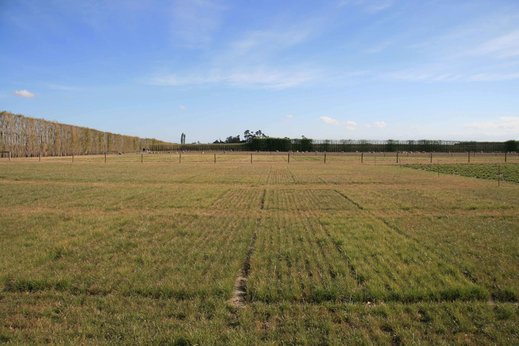Staying ahead when temperate becomes temperamental.
It’s another hot, sticky night and you can’t sleep. But you’re not the only one! If the mercury stays above 19oC after dark, some of your best team members are tossing and turning too.
Trouble is, they won’t just show up for work tomorrow tired and cranky. If this carries on for too long, they might not show up at all.
Such is the predicament in parts of New Zealand where a changing climate is already disrupting pastoral farming as we know it.
In this case, sleep-deprived perennial ryegrass is doing it hard. In response, those whose livelihoods rely on pasture are turning to new options. What can they show us about creating climate-resilient farm systems?
Hot and bothered
We all perform best under certain conditions. Ryegrass is no exception. A temperate grass, it grows most happily between 5ºC and 18ºC. When minimum overnight ‘lows’ get too high, however, it basically doesn’t get to sleep.
Exhausted by too many nights of heat, perennial ryegrass then can’t compete with aggressive, sub-tropical grasses and kikuyu that thrive through the balmy nights
In northern New Zealand this is increasingly common through summer (and it’s heading south).
So, to keep their home grown forage systems thriving into the future, New Zealand’s northern farmers are increasingly diversifying their pastures. Their targets? Plant species better adapted to heat.
Cocksfoot, fescue, annual, red and white clovers, lucerne, chicory and plantain are all on the menu. With more research, so too might be sub-tropical grasses and legumes of the type proven on farms in warmer parts of Australia.
“Because of the predicted impacts of climate change, we need to quickly move beyond the status quo of ryegrass and clover pastures, and be open to more resilient options. We need to research options for a warming climate, and learn from those who use them”
Resilient Pastures Farmer, Allister McCahon, Northland Diversified Forage Group.
A weather eye
Farmers in many areas north of the Central Plateau may be at the forefront of climate adaptation in New Zealand. But their experience is relevant to all of us.
As they literally acclimatise their farms to temperamental new weather patterns, they reinforce two truths – our pasture based systems are highly flexible, and we have many ways of adjusting them.
Even now our agricultural sector encompasses a huge range of pasture and forage systems, simply because regional climatology varies so widely.
If you’re farming in the deep south, for example, you might as well be in a separate country to the north, not just a separate island. And therein lies some reassurance in the face of uncertainty about climate change.
Been there, done that
More heat. New pests, weeds and diseases. Extreme periods of wet or dry (probably both). Less grass growth. More grass growth, but at different times of the year than now. Unexpected feed deficits.
Climate change scenarios for farms in different regions are as varied as New Zealand itself. The only consistent theme is that most places will be affected to a greater or lesser degree.
But here’s the thing – even if changes on your farm are new to you, chances are they’ve already been experienced, and worked around, by other farmers just like you, somewhere else in New Zealand.
So you won’t have to start with a blank piece of paper when the time comes to adapt to uncommon climatic patterns on your farm. Even better, there will almost certainly have been some research done on how best to deploy these techniques and systems.
-Feb-summer-2-WEB.jpg?height=345&width=519)
cocksfoot on right.

Same, but different
What might these climatic work-arounds look like? Growing different forage and crops to feed your animals is a likely starting point. And here we can look to both ends of the country for living examples.
As Northland moves towards diversified pastures, Southland is now growing more maize silage than anyone would have imagined not so long ago.
But changing what you grow – or where and when you grow it - doesn’t necessarily mean introducing completely new species. It may simply be a case of replacing some perennial pastures with short term hybrid ryegrass and annual legumes to make the most of times when growth is more reliable.
By the same token, you’ll probably need to grow more supplement to buffer periods when growth is not reliable, or expand the area you already use for forage crops. Remember too that new climate-adaptive cultivars of species we know well are also in the making.
-WEB.jpg?height=826&width=1102)
Pull the other one
Thinking about what you grow (or don’t grow) is one part of preparing for whatever a more temperamental climate brings to your farm.
But system changes could be equally helpful. Again, there are many potential levers to pull here to re-align feed demand with new and different patterns of feed supply. Altering your lambing or calving date, for example, may help you get more out of spring before the heat comes on in summer.
You might find running different classes of stock creates a better fit between supply and demand as pasture growth patterns become more erratic. Perhaps you’ll need to create extra stand-off areas as a contingency for extreme wet weather. Maybe you’ll team up with a buddy farm to guarantee supplies of supplement.
The list is long! And we know it can be overwhelming at times. That’s why we’re here to help. Your free Pasture Health Check is just a few clicks away, so don’t hesitate if you’d like to bounce some ideas around.
Book a free personal Pasture Health Check today at Barenbrug - Superior Pastures // Book a visit


